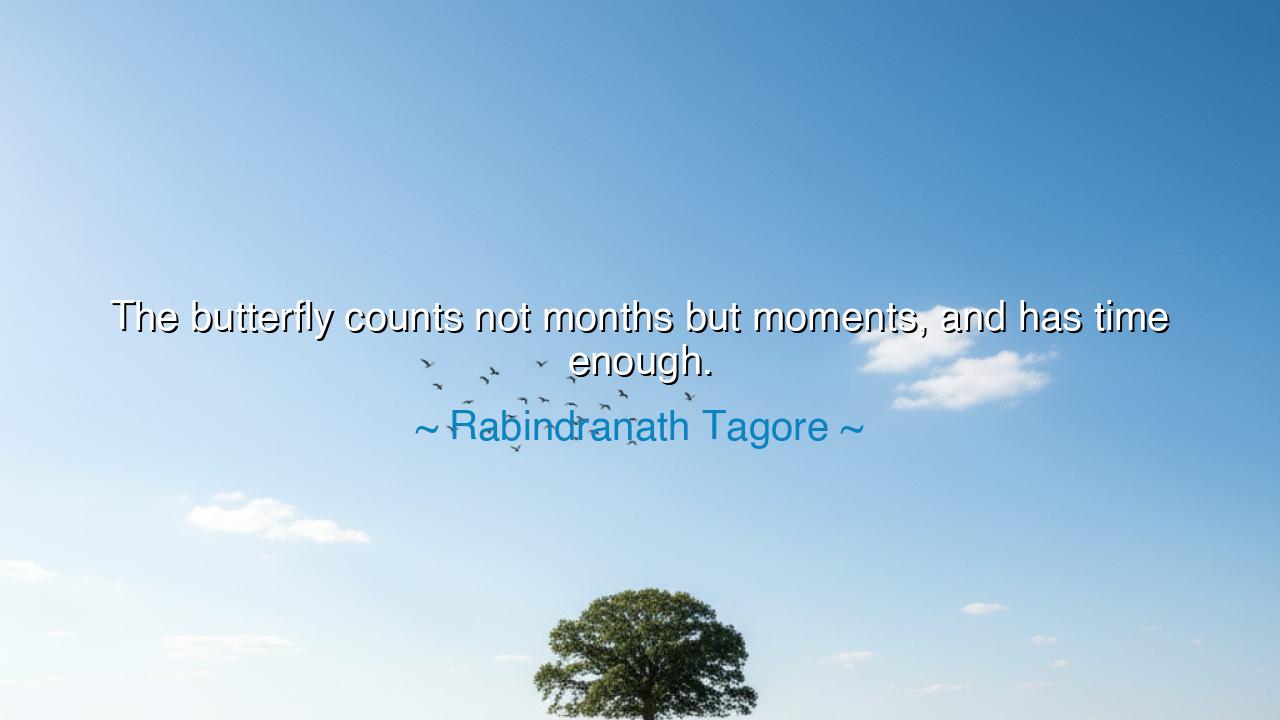
The butterfly counts not months but moments, and has time






Hear the luminous words of Rabindranath Tagore, poet of the East and sage of the human soul, who declared: “The butterfly counts not months but moments, and has time enough.” In this vision, Tagore lifts before us the fragile winged creature, whose life is but a brief spark compared to the years of man. And yet, the butterfly, though it lives only days, is not impoverished. It does not measure its existence by the length of months, but by the fullness of each fleeting moment. Thus, it possesses abundance, for its life, though short, is complete.
The butterfly has been from ancient times a symbol of transformation, of fragility, and of the soul. Emerging from the darkness of the chrysalis, it enters the light clothed in beauty, free in the air, unburdened by the heavy counting of days. To Tagore, who spoke often of eternity and the sacredness of the present, the butterfly is the teacher of time. It whispers to mankind that life is not a ledger of days but a flame of moments, and that one radiant hour lived fully may outweigh years wasted in forgetfulness.
The ancients, too, echoed this wisdom. Marcus Aurelius, emperor and philosopher, wrote in his meditations that a man need not live a thousand years, but live one day well to have lived a complete life. The Stoics taught that the present is all we truly own; the past has gone, and the future is uncertain. The butterfly is the living emblem of this truth—fragile yet fearless, short-lived yet fulfilled. It lives not in regret of the past, nor in fear of tomorrow, but in the dance of now.
History offers us many witnesses to this teaching. Consider Anne Frank, the young girl who, though hidden in the shadow of oppression, filled her diary with reflections of beauty, hope, and love. Her months were few, her days uncertain, and yet her words captured the radiance of life in its smallest details—the sky, the laughter of friends, the flicker of courage. Like the butterfly, she did not measure her life in its length, but in the depth of each moment she could hold. Her legacy reminds us that fullness is not in duration but in presence.
The meaning of Tagore’s words is thus: life’s value is not found in its span, but in its intensity and awareness. The butterfly, though it lives briefly, does not lament; it simply lives. So too should we cease to count the hours with anxiety and instead fill the hours with meaning. To rush toward the future or cling to the past is to miss the very wealth of life—the present moment, which alone contains eternity.
The lesson is clear: to live richly, one must learn from the butterfly. Be fully present. Cherish each conversation, each sunrise, each small act of kindness. Do not wait for great occasions to live, for the greatness of life is scattered in small, fleeting jewels. When we embrace each moment with gratitude, then like the butterfly we will find that we have time enough—not because our days are many, but because our days are full.
What, then, are the practical actions? Each day, pause to notice beauty, however small. Keep a journal, not of months and years, but of moments that stir your heart. Practice stillness, so that you may taste the present without being consumed by the noise of tomorrow. Offer kindness freely, as though each act were your last, and receive joy in the simple things. Live so that at the end, you may not lament the brevity of time, but rejoice that, like the butterfly, you lived fully while you could.
Thus Tagore’s words stand as a timeless hymn: “The butterfly counts not months but moments, and has time enough.” Carry this wisdom with you, O seeker of life, and learn to measure not by the length of your days, but by the fullness of your living. For in truth, to embrace the present is to taste eternity, and to live like the butterfly is to discover that every fleeting moment is already enough.






AAdministratorAdministrator
Welcome, honored guests. Please leave a comment, we will respond soon